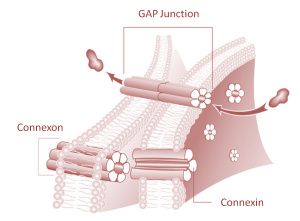This weekend I am flying to London to participate in the GAP Summit, which will take place in Cambridge next week. When I knew the initiative, just because of the name of the event and the topic to be developed, I realized that I had to be there, so it was great news being selected as one of the 100 Voices of Tomorrow in this first edition.
The first time I heard the concept of GAP was in the subject Animal cytology and histology, which I studied in the first year of my Degree.
In some types of mammalian cells, which by their nature need to have a strong interaction with neighboring cells, a special kind of channels called GAP junctions enable fast and efficient communication between them, without the need of chemical messengers as intermediaries.
To become established, the adjacent cells have to get really close to each other, leaving only 2 nm between them, and it is then when proteins called connexins, structured in 6-proteins-oligomers called connexons, align with those of its neighboring cell to form “bridges” between them.
The connexons form therein a hydrophilic channel that opens or closes in response to different stimuli, allowing the direct passage, cytoplasm to cytoplasm, of molecules up to 1000 daltons, which is impossible by other kind of channel.
GAP junctions appear at different animal tissues, such as heart or muscle cells, but they are particularly important in neuronal connections, being the basis of electrical synapses.
Few years later, I heard the concept of GAP in a totally different environment, where unfortunately we have not been able to evolve a method of communication as effective as the GAP junctions are.
The GAP between basic research and clinical practice, also known as Death Valley, was detected many years ago and has been written and debated extensively about it (I recommend this article in Nature, one of the first articles that tried this topic, or at least with more impact).
The signals sent by basic researchers in the form of papers and patents, in most cases are not compatible with receptors in physicians, waiting for that solution that patients need, and this lack of understanding leads to a large number of R&D projects developed in our universities and research centers that never reach the needs of the population.
From my point of view, besides the rapprochement and goodwill on the part of clinicians and basic researchers, reaching to the minimum distance of 2 nm to enable the establishment of the connection, we also need to come into play other actors, that as connexins do, can establish the necessary bridges for the R&D projects do not fall into the intercellular gap.
When it comes to knowledge transfer, as for the neural networks, we cannot afford a high percentage of our signals dissipate in the synaptic space, as it happens with the signals mediated by neurotransmitters, and therefore we need to create innovation platforms as efficient as GAP junctions are, which allow the message of the nerve impulse to be transmitted immediately and without errors.

